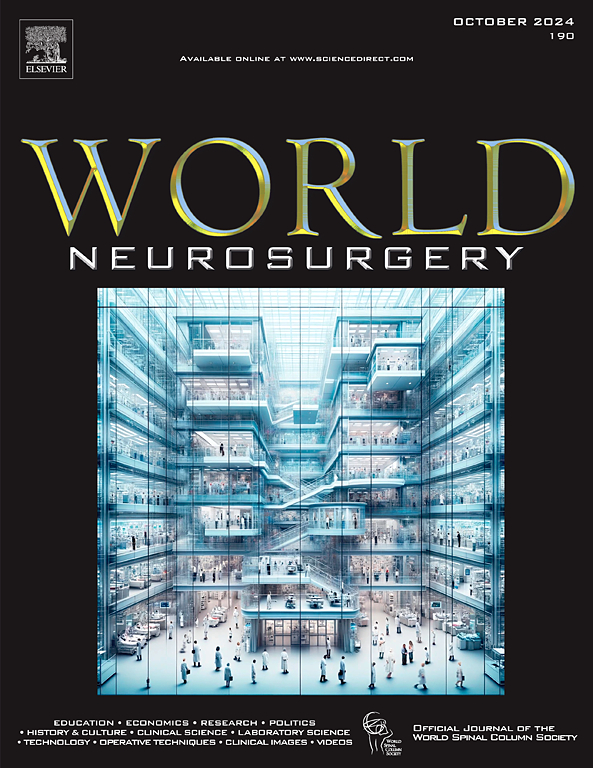Full-Endoscopic Minimally-Invasive Trans-Magendie Approach to the Fourth Ventricle: An Anatomical Feasibility Study
IF 1.9
4区 医学
Q3 CLINICAL NEUROLOGY
引用次数: 0
Abstract
Background
The telovelar approach provides access to the caudal two-thirds of the fourth ventricle without requiring vermian splitting. Indeed, the traditional microsurgical approach is often limited by a restricted cranial angle of attack and visualization, making it challenging to evaluate the patency of the aqueduct. To address this limitation, resection of the posterior arch of C1 is frequently performed. This study aims to describe and evaluate the feasibility of a full-endoscopic, retractorless, trans-Magendie approach to the inferior third of the fourth ventricle, avoiding removal of the posterior arch of C1 through a minimally invasive burr-hole suboccipital craniotomy.
Methods
Four formalin-fixed, injected cadaveric heads were investigated. A step-by-step anatomic description of the proposed approach is provided.
Results
Adequate cranial and lateral visualization of the aqueduct and fourth ventricle floor was achieved without removing the posterior arch of C1.
Conclusions
The full-endoscopic trans-Magendie approach enables adequate visualization of the inferior two-thirds of the fourth ventricle and the caudalmost portion of the aqueduct while avoiding the need for a C1 laminectomy and significantly reducing the craniotomy size.
全内窥镜微创经magendie入路进入第四脑室:解剖学可行性研究。
介绍:端部入路可进入第四脑室尾侧三分之二的区域,而不需要蚓状分裂。事实上,传统的显微外科入路常常受到颅骨攻角和可视化的限制,使得评估输水管道的通畅性具有挑战性。为了解决这一局限性,经常进行C1后弓切除术。目的:描述和评估全内窥镜、无牵开器经magendie入路进入第四脑室下三分之一的可行性,避免通过微创枕下钻孔开颅术切除C1后弓。方法:对4个注射福尔马林固定的尸体头部进行研究。提供了所建议的方法的一步一步的解剖描述。结果:在不切除C1后弓的情况下,实现了输水管道和第四脑室底的充分的颅侧可见。结论:全内镜下经magendie入路可以充分显示第四脑室的下三分之二和导尿管的近尾部分,同时避免了C1椎板切除术的需要,并显著减小了开颅面积。
本文章由计算机程序翻译,如有差异,请以英文原文为准。
求助全文
约1分钟内获得全文
求助全文
来源期刊

World neurosurgery
CLINICAL NEUROLOGY-SURGERY
CiteScore
3.90
自引率
15.00%
发文量
1765
审稿时长
47 days
期刊介绍:
World Neurosurgery has an open access mirror journal World Neurosurgery: X, sharing the same aims and scope, editorial team, submission system and rigorous peer review.
The journal''s mission is to:
-To provide a first-class international forum and a 2-way conduit for dialogue that is relevant to neurosurgeons and providers who care for neurosurgery patients. The categories of the exchanged information include clinical and basic science, as well as global information that provide social, political, educational, economic, cultural or societal insights and knowledge that are of significance and relevance to worldwide neurosurgery patient care.
-To act as a primary intellectual catalyst for the stimulation of creativity, the creation of new knowledge, and the enhancement of quality neurosurgical care worldwide.
-To provide a forum for communication that enriches the lives of all neurosurgeons and their colleagues; and, in so doing, enriches the lives of their patients.
Topics to be addressed in World Neurosurgery include: EDUCATION, ECONOMICS, RESEARCH, POLITICS, HISTORY, CULTURE, CLINICAL SCIENCE, LABORATORY SCIENCE, TECHNOLOGY, OPERATIVE TECHNIQUES, CLINICAL IMAGES, VIDEOS
 求助内容:
求助内容: 应助结果提醒方式:
应助结果提醒方式:


